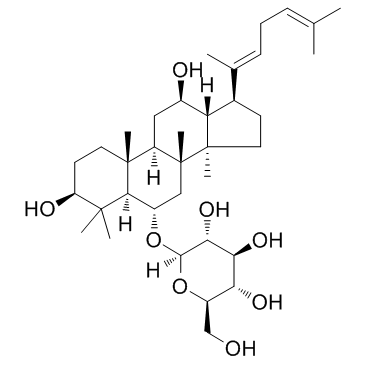Ginsenoside Rh4 |
| Catalog No.GC32998 |
Products are for research use only. Not for human use. We do not sell to patients.

Cas No.: 174721-08-5
Sample solution is provided at 25 µL, 10mM.
Ginsenoside Rh4 is a rare saponin obtained from Panax notoginseng. Ginsenoside Rh4 activates Bax, caspase 3, caspase 8, and caspase 9. Ginsenoside Rh4 also induces autophagy.
Ginsenoside Rh4 causes cytochrome C release and activates the death receptor Fas, the pro-apoptotic protein Bax, and caspase 3, caspase 8, and caspase 9. Ginsenoside Rh4 induces caspase-dependent apoptosis via both the intrinsic and extrinsic pathways in Caco-2 and HCT-116 cells. The CCK-8 assay reveals that Ginsenoside Rh4 can significantly inhibit the growth of colorectal carcinoma cells, such as Caco-2 and HCT-116 cells, to varying degrees. Ginsenoside Rh4 dramatically reduces cell viability in a concentration- and time-dependent manner. In particular, treatment with 120 and 180 μM Ginsenoside Rh4 results in marked Caco-2 cell death of 44.51±1.23% and 75.74±2.91%, respectively, after incubation for 48 h. Similar results are observed in HCT-116 cells treated with concentrations of 120 μM (33.62±1.98%) and 180 μM Ginsenoside Rh4 (59.88±2.31%). In contrast, concentrations of Rh4 from 120 to 300 μM cause no obvious toxic effects on the normal human colon epithelial cell line CCD-18Co, and a slight difference in the effect is observed between 24 and 48 h of treatment. In the colony formation assay, the number of colonies is found to be significantly decreased in Caco-2 and HCT-116 cells, whereas the number of colonies is almost unchanged in CCD-18Co cells[1].
To assess whether Ginsenoside Rh4 can inhibit the growth of colorectal cancer, a colorectal cancer xenograft model is established by inoculating nude mice with Caco-2 cells. Mice treated with 20 and 40 mg/kg Ginsenoside Rh4 and 40 mg/kg CAMPTO exhibit smaller tumors than the control after 30 days of treatment, showing inhibition rates of 29.91%, 66.30% and 77.82%, respectively. However, there is a significant difference in body weight between the Ginsenoside Rh4-treated group and the CAMPTO-treated group. The body weights of the 20 and 40 mg/kg Ginsenoside Rh4-treated groups (15.95±0.35 g and 18.35±0.44 g) are markedly higher, whereas the body weight of the CAMPTO-treated group is lower (10.85±0.28 g) than that of the solvent control group (14.19±0.25 g)[1].
[1]. Wu Q, et al. Ginsenoside Rh4 induces apoptosis and autophagic cell death through activation of the ROS/JNK/p53 pathway in colorectal cancer cells. Biochem Pharmacol. 2018 Feb;148:64-74.
Average Rating: 5 (Based on Reviews and 31 reference(s) in Google Scholar.)
GLPBIO products are for RESEARCH USE ONLY. Please make sure your review or question is research based.
Required fields are marked with *




